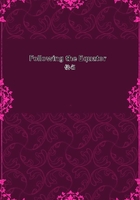
第175章
Presently there was a slight stir among the score of persons present, and all moved reverently out of the path and ceased from talking. A funeral procession entered the great gate, marching two and two, and moved silently by, toward the Tower. The corpse lay in a shallow shell, and was under cover of a white cloth, but was otherwise naked. The bearers of the body were separated by an interval of thirty feet from the mourners. They, and also the mourners, were draped all in pure white, and each couple of mourners was figuratively bound together by a piece of white rope or a handkerchief--though they merely held the ends of it in their hands. Behind the procession followed a dog, which was led in a leash. When the mourners had reached the neighborhood of the Tower--neither they nor any other human being but the bearers of the dead must approach within thirty feet of it--they turned and went back to one of the prayer-houses within the gates, to pray for the spirit of their dead.
The bearers unlocked the Tower's sole door and disappeared from view within. In a little while they came out bringing the bier and the white covering-cloth, and locked the door again. Then the ring of vultures rose, flapping their wings, and swooped down into the Tower to devour the body. Nothing was left of it but a clean-picked skeleton when they flocked-out again a few minutes afterward.
The principle which underlies and orders everything connected with a Parsee funeral is Purity. By the tenets of the Zoroastrian religion, the elements, Earth, Fire, and Water, are sacred, and must not be contaminated by contact with a dead body. Hence corpses must not be burned, neither must they be buried. None may touch the dead or enter the Towers where they repose except certain men who are officially appointed for that purpose. They receive high pay, but theirs is a dismal life, for they must live apart from their species, because their commerce with the dead defiles them, and any who should associate with them would share their defilement. When they come out of the Tower the clothes they are wearing are exchanged for others, in a building within the grounds, and the ones which they have taken off are left behind, for they are contaminated, and must never be used again or suffered to go outside the grounds. These bearers come to every funeral in new garments. So far as is known, no human being, other than an official corpse-bearer--save one--has ever entered a Tower of Silence after its consecration. Just a hundred years ago a European rushed in behind the bearers and fed his brutal curiosity with a glimpse of the forbidden mysteries of the place. This shabby savage's name is not given; his quality is also concealed. These two details, taken in connection with the fact that for his extraordinary offense the only punishment he got from the East India Company's Government was a solemn official "reprimand"--suggest the suspicion that he was a European of consequence.
The same public document which contained the reprimand gave warning that future offenders of his sort, if in the Company's service, would be dismissed; and if merchants, suffer revocation of license and exile to England.
The Towers are not tall, but are low in proportion to their circumference, like a gasometer. If you should fill a gasometer half way up with solid granite masonry, then drive a wide and deep well down through the center of this mass of masonry, you would have the idea of a Tower of Silence. On the masonry surrounding the well the bodies lie, in shallow trenches which radiate like wheel-spokes from the well. The trenches slant toward the well and carry into it the rainfall.
Underground drains, with charcoal filters in them, carry off this water from the bottom of the well.